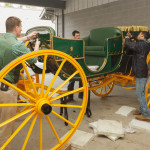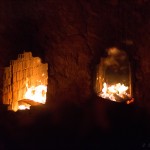
When the word “fire!” rang out in colonial America, devastation was always a possibility. Every able-bodied hand within hailing distance was needed to contain the flames. Beginning April 17, guests will be able to get a taste of what it meant to be part of a colonial community in an emergency by lining up as part of the bucket brigade, or perhaps even taking a turn at pumping water from the fire engine.
The drill, which will take place daily at 2:30 p.m. between the Magazine and the Guardhouse, marks the return of a popular program offered infrequently in recent years. The fire engine is a brand new replica manufactured by Glinkowski Carriages of Gostyń, Poland, the same folks who recently refurbished two coaches and the old fire engine (which remains in reserve).
The original, on display in the Art Museums of Colonial Williamsburg, is a mid-1700s Newsham fire engine. Richard Newsham was a London button maker, of all things, who acquired a patent in 1721 for his “new water engine for quenching and extinguishing fires.” There were periodic improvements in its design, but the Newsham engine remained popular in England until the 1830s, when it was supplanted by a more compact, horse-drawn model.
Several cities in colonial America purchased one of Newsham’s models, beginning with Philadelphia in 1730. Williamsburg first ordered a fire engine (and four dozen leather buckets) in 1754, and odds are it was also a Newsham. We know it was in use by 1756, when it was effective in preventing the fire that destroyed Peter Hay’s Apothecary Shop in under half an hour from spreading out of control.
Its popularity was attributable to its ability to deliver a steady spray about 45 yards at full power. (The military interpreters heading the program are eager to find out just how far the stream will go with this one.) It could easily reach second floors, which was as high as most buildings were then, and it packed enough wallop to punch through glass to douse an interior fire.
The fire engine requires some serious manpower to operate at full effectiveness. In all, between 10 and 40 guests will be able to participate 18th-century firefighting. Many, especially the younger folks, will be asked to be part of the bucket brigade, passing pails of water from the source (two huge tubs) to the fire engine, where they are poured into a reservoir. A screen prevents debris from getting into the tank.
The engine is also equipped with a long hose, allowing water to be drawn from a pond or other available water source.
Manning the pump is hard work. As many as four people can stand up on the raised foot treadles on either side, gripping a bar as they use their feet to pump the two-cylinder machine up and down. Six or eight more people take hold of the hand levers on either side, pumping in time with the others.
One person mounts the top of the engine to direct the spray from the long spout.
The wheeled engine is nearly ten feet long and about four feet wide. It weighs about 700 pounds empty, and closer to a ton when filled with 100-plus gallons of water. Despite its wheels, it would have required a team of people to rush the heavy vehicle to the location of a fire.
Williamsburg escaped the kind of blaze that could destroy entire cities, but the colonial capital still experienced its share of fires. William & Mary’s Wren Building burned in 1705, the Capitol in 1747. A 1754 fire that claimed two houses and a storehouse, and severely damaged a tavern, helped precipitate the decision to purchase a fire engine. A coffee merchant staying at the tavern, Marot’s Ordinary, described the futile effort to contain the fire with few supplies:
With any tolerable management, the fire might easily have been extinguished, but nothing was sure for a great while but uproar, confusion and disorder…. the rope to my well, the nearest and only water within a good way, was broke or cut after drawing the first or second bucket….
Had Mr. Walthoe’s house been covered with wet bags or blankets, that would have preserved it, but for more than an hour not a ladder (or other useful implement) could hardly be met with. My Pails, Buckets, Tubs, Axes, Spades, etc. etc. were indeed delivered immediately, but except the well bucket which was secured at the bottom of the well, I never received one thing any more. The Capitol tho’ more than 200 feet distant was by its eastern situation in great danger of being burnt a second time, the shingles catching several times.
In 1761 the General Assembly allowed Williamsburg’s Common Council to tax residents for new wells and pumps around town to make it easier to fight fires. A subsequent act provided for hiring firemen to look after the equipment. Little, if any, action appears to have been taken.
A decade later, “Timothy Telltruth” complained in the Virginia Gazette that the town, consisting primarily of wooden houses, was “quite incapable of resisting any conflagration that may happen.”
After the Governor’s Palace burned in December 1781, Gen. Rochambeau, still in town after the victory in Yorktown, wrote to George Washington that the nearby Wythe House, where the Frenchman was staying, “was covered all the night long with a rain of red hot ashes.”
Imminent danger has a way of bringing people together. When fire threatened the community, they set aside their differences to fight it. Not a bad model.
The fire engine program occurs daily at 2:30 p.m. beginning April 17. Admission is included with your Colonial Williamsburg ticket. The bucket brigade is recommended for children 8 and up. Adults who are willing and able to do strenuous activity can help operate the fire engine.




How did you choose the paint colors for the replica? Are they based off of the paint samples on the original fire engine? Is there any particular reason for an 18th century fire engine to be brightly colored, or is it for the same reasons as today?
Great post!
I remember manning the fire engine a few years ago. It’s harder than it looks, you really have to coordinate with the team on the other side. but the water went on the roof of the guardhouse. Very neat…